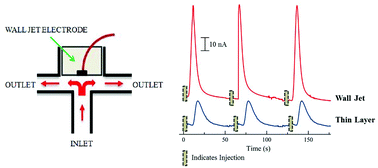Microchip-based electrochemical detection using a 3-D printed wall-jet electrode device
Abstract
Three dimensional (3-D) printing technology has evolved dramatically in the last few years, offering the capability of printing objects with a variety of materials. Printing microfluidic devices using this technology offers various advantages such as ease and uniformity of fabrication, file sharing between laboratories, and increased device-to-device reproducibility. One unique aspect of this technology, when used with electrochemical detection, is the ability to produce a microfluidic device as one unit while also allowing the reuse of the device and electrode for multiple analyses. Here we present an alternate electrode configuration for microfluidic devices, a wall-jet electrode (WJE) approach, created by 3-D printing. Using microchip-based flow injection analysis, we compared the WJE design with the conventionally used thin-layer electrode (TLE) design. It was found that the optimized WJE system enhances analytical performance (as compared to the TLE design), with improvements in sensitivity and the limit of detection. Experiments were conducted using two working electrodes – 500 μm platinum and 1 mm glassy carbon. Using the 500 μm platinum electrode the calibration sensitivity was 16 times higher for the WJE device (as compared to the TLE design). In addition, use of the 1 mm glassy carbon electrode led to limit of detection of 500 nM for catechol, as compared to 6 μM for the TLE device. Finally, to demonstrate the versatility and applicability of the 3-D printed WJE approach, the device was used as an inexpensive electrochemical detector for HPLC. The number of theoretical plates was comparable to the use of commercially available UV and MS detectors, with the WJE device being inexpensive to utilize. These results show that 3-D-printing can be a powerful tool to fabricate reusable and integrated microfluidic detectors in configurations that are not easily achieved with more traditional lithographic methods.


 Please wait while we load your content...
Please wait while we load your content...